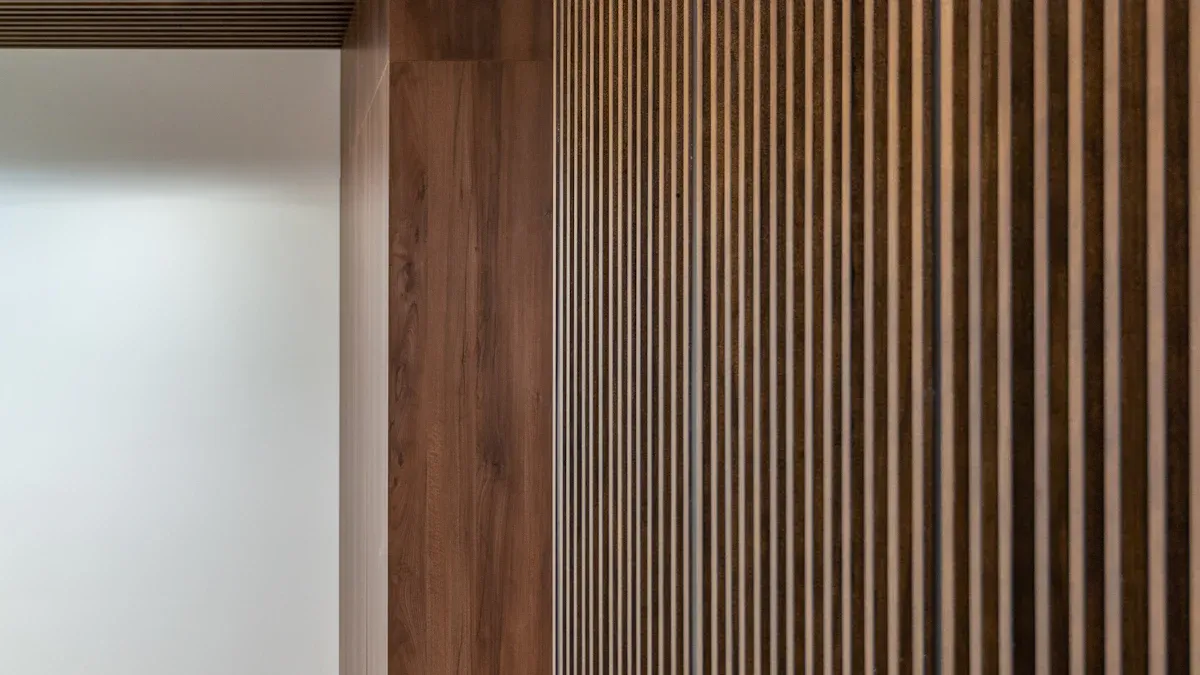
15 Sep A Complete Guide to Wall Paneling Materials in 2025
Table of Contents
If you want the best wall panelling materials in 2025, you have many choices. Here is a quick look at some popular options:
Material | Features | Where You’ll See Them |
|---|---|---|
Warm, natural look | Homes, hotels, offices | |
Metal panels | Tough, weather-resistant | Commercial spaces |
Concrete panels | Strong, fire-resistant | Structural projects |
Gypsum panels | Lightweight, affordable | Interior walls, ceilings |
Fiber and plastic panels | Flexible, water-resistant | Kitchens, bathrooms |
There are new trends, too. You can find magnesium oxide boards for eco-friendly, fire-safe spaces. 3D wall panelling gives walls bold textures. Think about what your room needs and your style before you choose.
Key Takeaways
Pick wall paneling that fits your room’s needs. If your room gets wet, use water-resistant materials like PVC or fiber cement.
Think about how wall panels look. They can make your space look better. Wall panels can hide marks and make rooms feel nice.
Focus on how strong and easy to clean the panels are. PVC and WPC do not need much care. They do not get damaged easily. These are good for busy places.
Look at eco-friendly choices like magnesium wall boards. They help protect against fire and water. They are also safe for the planet.
Spend your money carefully. Choose cheaper materials like MDF or peel-and-stick panels. These choices look good and do not cost too much.
Types of Wall Panelling
 Magnesium Wall Board
Magnesium Wall Board
Magnesium wall board is a new choice for walls. It is strong, safe, and good for the planet. Here is how it matches up with other materials:
Characteristic | Description |
|---|---|
Fire Resistance | It does not burn easily, better than old materials. |
Moisture and Mold Protection | It keeps out water, so mold and mildew do not grow. |
Eco-friendliness | It uses natural minerals, can be recycled, and has no bad chemicals. |
Strength and Durability | It is much tougher than drywall and does not break easily. |
Ease of Installation | It is light, easy to carry, and you can cut it with normal tools. |
Sound Insulation | It is thick, so it helps keep rooms quiet. |
Long-term Cost-effectiveness | It costs more at first, but you save money later because it lasts longer. |
Tip: Use magnesium wall board where you need fire and water safety. It is great for kitchens, bathrooms, and basements. It also works well in schools and hospitals because it is strong.
Wood
Wood makes rooms feel warm and classic. You can pick from oak, pine, or walnut. Here is a simple look at wood:
Advantages | Disadvantages |
|---|---|
Aesthetic appeal | It can be expensive |
Durability | Needs regular care |
Acoustic benefits | Can change with weather |
Insulation properties | Can get scratched or dented |
Ease of installation | Not always eco-friendly |
Customization options | Might change color over time |
Environmental considerations | N/A |
People like wood because it looks nice and helps with sound. It is good for living rooms, offices, and hotels. But wood needs care and can cost a lot. If you want a cozy and classic room, wood is a good choice.
MDF
MDF is a cheaper way to panel walls. It is smooth and easy to paint. Here is how it compares:
Material | Water-Resistant | Durability |
|---|---|---|
MDF | Not unless sealed | Medium |
Solid Wood | Yes | High |
PVC Panels | Yes | High |
MDF is best for dry places like bedrooms or halls. You can make many shapes with it. If you use it in wet places, seal it first. If not, it can swell or bend.
PVC
PVC panels are good for wet rooms. They have these features:
They have no cracks, so water stays out.
One person can put them up because they are light.
They are waterproof and do not get moldy like tiles.
PVC is great for bathrooms, kitchens, and laundry rooms. You can clean them fast, and they last a long time.
Fiber Cement
Fiber cement panels are strong and look nice. You can use them in many ways:
As art panels to make rooms special.
On office walls to stand out.
For floors in busy places because they are tough.
On fancy walls in big homes.
To make tables and other furniture.
Around fireplaces because they do not burn.
For green building since they use eco-friendly stuff.
Fiber cement panels give a modern look and do not get ruined by water.
Gypsum
Gypsum panels are light and easy to use. They stop fire and block sound.
Aspect | Description |
|---|---|
Fire Resistance | |
Sound Insulation | They keep rooms quiet and private. |
Applications | Used in hospitals, schools, and apartments. |
Gypsum is good for ceilings and inside walls. It keeps people safe and makes rooms quieter.
Stone Veneer
Stone veneer panels look like real stone but cost less. Here is what you should know:
They are cheaper than real stone.
They are light and easy to put up.
You can pick from many designs.
You might see lines or patterns that repeat.
They are not as strong as real stone and may break.
If not installed right, water can get in.
Sunlight can make them fade.
Stone veneer is good for accent walls, fireplaces, and outdoor kitchens. They look nice and save money, but check for water problems.
FRP
FRP panels are strong and keep places clean. You see them where things must stay dry and safe.
Feature | Benefit |
|---|---|
Durability | They last a long time and need little fixing. |
Hygiene | The smooth surface stops germs and mold. |
Mold and Mildew Resistance | They keep air healthy by stopping mold. |
Waterproofing | They are sealed, so water cannot get in. |
Easy Maintenance | You only need to clean them with soap and water. |
FRP panels stop germs and mold, so they are good for kitchens, bathrooms, and hospitals.
You just clean them with soap.
The smooth surface keeps stains away and is easy to wipe.
Fabric
Fabric wall panels are soft and help with sound. You can use them to:
Soak up sound and stop echoes.
Make rooms quieter.
Trap sound, so noise does not bounce around.
Make rooms look and feel cozy.
Fabric panels are good for offices, classrooms, and theaters. They make rooms quieter and more comfortable.
Glass
Glass wall panels bring in light and style. Here are some ways to use them:
Design Option | Impact on Natural Light |
|---|---|
Bi-fold Glass Doors | Let in lots of sunlight. |
LED-Embedded Glass Wall | Look cool and let light pass through. |
Artistic Glass Wall | Make rooms pretty and bright. |
Mirrored Glass Wall | Bounce light and make rooms look bigger. |
Acoustic Glass Wall | Block noise but keep rooms bright. |
Sliding Glass Wall | Save space and let in light. |
Outdoor Glass Wall for Patios | Connect inside and outside, add sunlight. |
Glass Wall with Metal Accents | Look special and stay clear. |
Stained Glass Wall | Add color and let some light in. |
Minimalist, Frameless Glass Walls | Look modern and let in lots of light. |
Smart Glass | Give privacy or let in light when you want. |
Glass walls make rooms feel open and sunny.
You can use them for doors, walls, or room dividers.
They look stylish and let sunlight in.
Metal
Metal wall panels are tough and last a long time. You see them in busy places like hallways.
Metal panels do not get damaged easily. You do not need to fix them often. Check for dirt or damage after storms or every season. If you live near the ocean, have a pro check them every few years.
Note: Metal panels are good for stores or modern homes. They look sleek and can handle lots of use.
Laminate
Laminate wall panels look nice and do not cost much. You can pick from many colors and styles.
It is easy to put up and does not cost a lot.
You can choose many designs.
Laminate is strong and does not need much care.
Laminate is good for living rooms, offices, and bedrooms. You get a fancy look for less money.
3D Panels
3D wall panels make your walls stand out. Here is why you might like them:
They make walls look cool and different.
They add depth and texture to plain walls.
3D panels help with sound and keep rooms comfy.
3D panels make rooms interesting and can make small spaces seem bigger.
The bumpy surface helps stop noise, which is good for busy homes or offices.
Tip: Use 3D panels on special walls or in places where you want to make a statement.
Benefits
 Aesthetic
Aesthetic
You want your space to look great, right? Wall panelling gives you tons of design choices. You can go for a modern vibe, a rustic feel, or even something classic.
You get to hide ugly marks or cracks on your walls.
Wall panelling makes rooms more attractive and welcoming.
You can pick colors, textures, and patterns that match your style.
Decorative panels also protect your walls from scratches and stains, so your space stays looking fresh. If you have kids or pets, you’ll love how wall panelling keeps your walls safe from everyday wear.
Tip: WPC wall panels stand out because they mix style, durability, and sustainability. They’re water-resistant, so they work well in places with lots of moisture. You get a beautiful look that lasts.
Insulation
Do you want a room that feels cozy and quiet? Wall panelling helps with both thermal and sound insulation.
Mineral wool and fiberglass panels absorb sound and keep noise from traveling between rooms. You get a peaceful space, even if things get loud outside.
Mass-loaded vinyl blocks sound, making it perfect for walls in bedrooms or home theaters.
Mineral wool panels also keep heat in during winter and out during summer, so your room stays comfortable.
Wall panelling can make your home quieter and help you save on energy bills.
Durability
You need walls that last, especially in busy areas.
PVC panels are tough, easy to clean, and resist mold and termites.
WPC panels combine wood and plastic, so they’re strong and moisture-resistant.
PVC panels handle impacts and water, making them perfect for bathrooms and kitchens.
WPC panels look like wood but need less care and stand up to humidity, mold, and rot.
Wall panelling protects your walls from damage and keeps them looking new, even in high-traffic spots. You spend less time fixing and more time enjoying your space.
Material Comparison
Affordability
You probably want to know how much wall paneling costs before you start your project. Prices can change a lot depending on the material you pick. Here’s a quick look at what you might pay in 2025:
Material Type | Material Cost ($/sq.ft) | Installation Cost ($/sq.ft) |
|---|---|---|
PVC | $1.50 | |
WPC | $2.50 – $4.00 | $1.80 |
Solid Wood | $405.12 – $579.12 (per job) | $405.12 – $579.12 (per job) |
For a 12×12 room, the average installation cost is about $3,600. Some jobs can be as low as $1,000 or as high as $15,000. If you want something fancy like overlay panels, you might pay up to $40 per square foot. Shiplap and wainscoting can be budget-friendly, starting at just $1 per square foot.
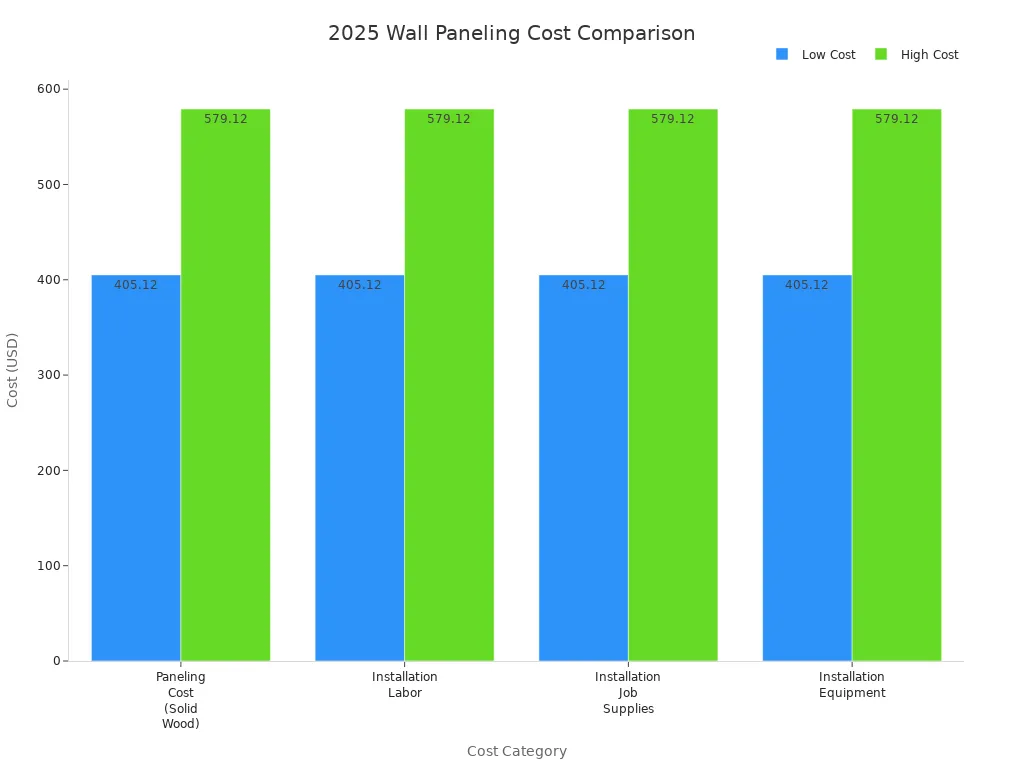
Tip: PVC and WPC panels give you a stylish look without breaking the bank. They also keep installation costs low.
Maintenance
You want your walls to look good with little effort. Some materials need more care than others. Here’s what you can expect:
PVC Panels: You only need to wipe them down with a damp cloth and mild soap. They stay clean and shiny with almost no work.
FRP Panels: These need more cleaning because their surface can trap dirt. You might have to scrub them sometimes.
Wood Panels: You should dust them often and polish them to keep their shine. They may need touch-ups if they get scratched.
WPC Panels: These are easy to maintain. They resist stains and moisture, so you spend less time cleaning.
Note: If you want low-maintenance walls, PVC and WPC are your best bet.
Style
You want your space to match your taste. Some wall paneling materials give you more choices than others. Take a look at this table:
Material | Versatility | Characteristics |
|---|---|---|
MDF | High | Paintable, textured, budget-friendly |
Wood | High | Natural grain, stains or paints, many widths |
PVC | Moderate | Moisture-resistant, easy to clean, simple designs |
WPC | High | Modern looks, 3D designs, water-resistant, sustainable |
MDF panels let you pick colors and textures for any room.
Wood panels work for rustic or modern styles and show off natural beauty.
PVC panels look like wood but need less care, perfect for bathrooms.
WPC panels offer cool 3D designs and marble finishes. They fit modern homes and busy spaces.
Want a wall that stands out? Try WPC panels for bold designs and easy upkeep.
Choosing Wall Panelling
 Room Guide
Room Guide
Picking the right wall panelling for each room makes a big difference. You want your living room to feel cozy, your bathroom to stay dry, and your kitchen to look clean. Here’s a quick guide to help you match materials to your space:
Room Type | Key Considerations |
|---|---|
Living Room | Decorative touch, material and design adaptability to décor. |
Bathroom | Water-resistant materials like plastic or PVC, easy to clean, moisture resistance. |
Kitchen | Prioritize waterproof and moisture-proof panels, such as UV marble or flexible stones. |
Commercial | Fire resistance for safety in high-security areas. |
Conference | Thick wall panels for sound insulation. |
Tip: Always check if the panel is moisture-proof before using it in bathrooms or kitchens. You’ll avoid mold and keep your walls looking fresh.
Style Match
You want your wall panelling to fit your home’s style. Think about the mood you want in each room. Here are some ideas to help you get a look that feels just right:
Use beadboard in soft whites or seafoam greens for a coastal vibe.
Try raw wood or metal accents if you like an industrial look.
Pair vintage furniture with antique-style molding for a classic feel.
Mix styles for a unique space, but keep colors similar so nothing clashes.
Pick molding that matches your home’s overall design for a smooth flow.
Note: Always consider the room’s function when choosing molding styles. This helps your space look good and work well.
Budget Tips
You don’t have to spend a lot to get great wall panelling. Here are some ways to save money and still get the look you want:
Use lighter colors and simple patterns in small rooms. Go bold in bigger spaces.
Choose MDF, PVC, or peel-and-stick panels for affordable options.
Look for DIY-friendly kits. Peel-and-stick or interlocking panels make installation easy.
Hire a pro for large or tricky projects to get a perfect finish.
Most panels just need dusting and a quick wipe to stay clean.
Think about eco-friendly choices like reclaimed wood or recycled composites.
Tip: Watch online videos and read instructions before you start. Planning helps you avoid mistakes and extra costs.
You’ve seen how wall panelling can protect your walls, improve insulation, and make your rooms quieter. Each material has its own perks—like MDF’s eco-friendliness, fabric’s sound absorption, or glass’s bright look. Some options, such as magnesium wall board, offer extra strength and save money over time. If you want to explore more, visit a showroom, talk to a design consultant, and see what fits your style. Take your time, compare the choices, and pick what works best for your home.
FAQ
What is the easiest wall paneling material to install yourself?
PVC and peel-and-stick panels are the easiest for DIY projects. You can cut them with basic tools and snap or stick them onto your wall. No special skills needed!
How do I clean wall panels?
Most panels just need a soft cloth and mild soap. For PVC or FRP, wipe with a damp cloth. For wood, dust often and use wood polish. Always check the care instructions.
Can I use wall panels in bathrooms or kitchens?
Yes! Choose water-resistant panels like PVC, FRP, or fiber cement. These materials handle moisture well and stop mold. Avoid regular wood or MDF in wet areas unless sealed.
What’s trending in wall paneling for 2025?
3D panels and magnesium wall boards are hot right now. You’ll also see more eco-friendly options and bold textures. People love panels that mix style with easy care.

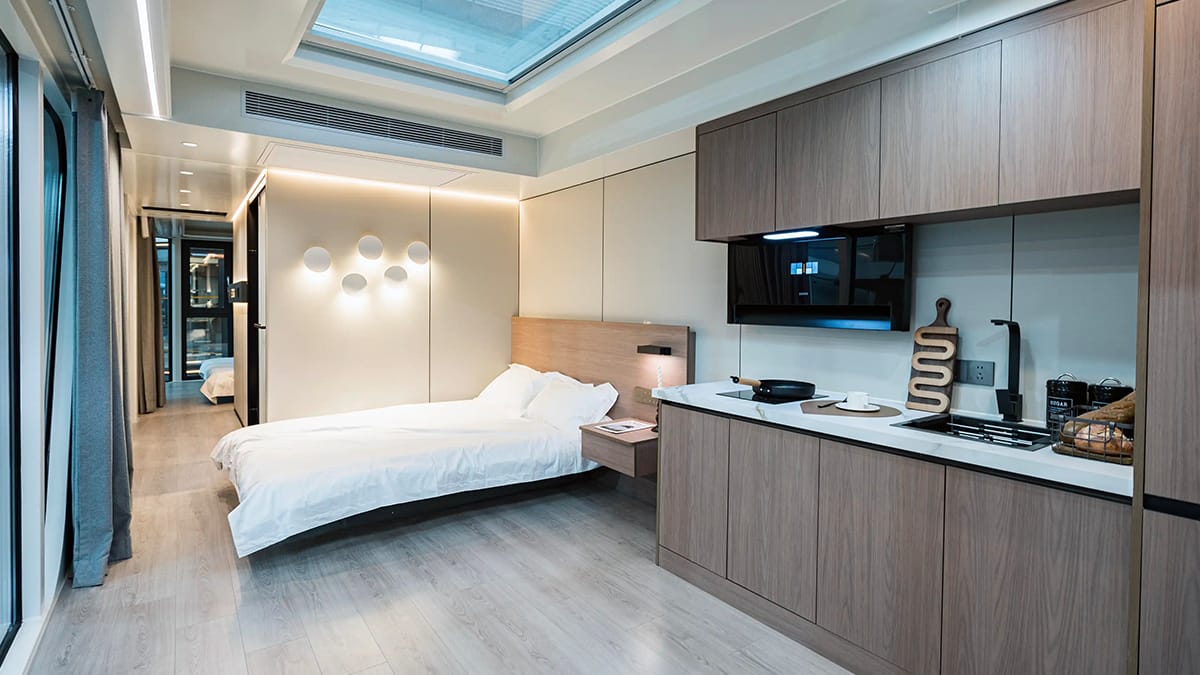 Magnesium Wall Board
Magnesium Wall Board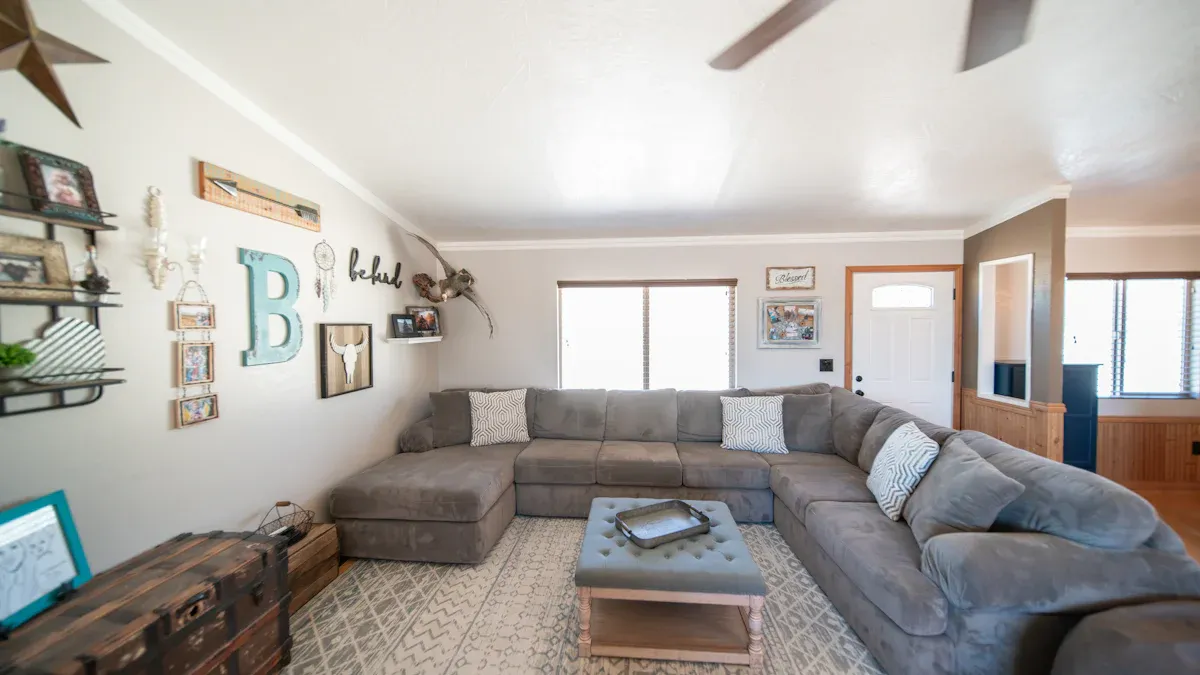 Aesthetic
Aesthetic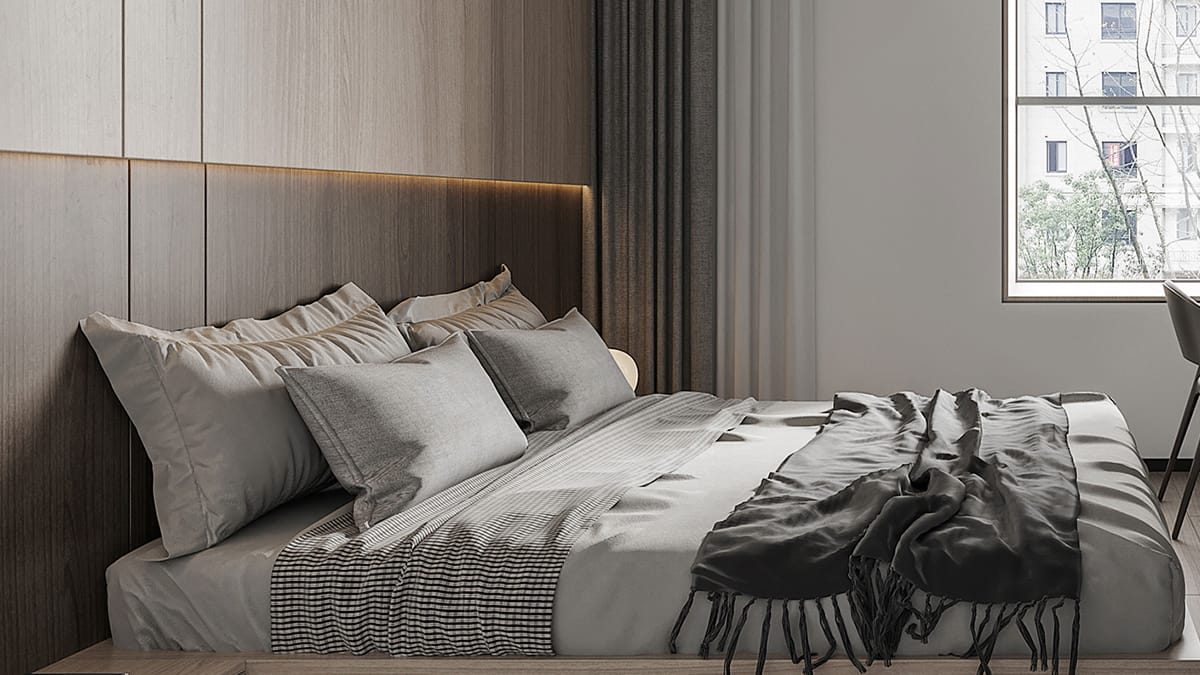 Room Guide
Room Guide